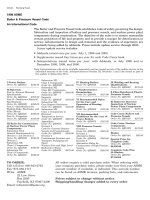Process Engineering Equipment Handbook 2009 Part 11 ppt
Bạn đang xem bản rút gọn của tài liệu. Xem và tải ngay bản đầy đủ của tài liệu tại đây (1.41 MB, 80 trang )
disastrous failures. This can be avoided and disc lives extended to >100,000 h by
using performance-monitoring software to analyze changes to the disc cooling.
Note that before this was done, changing the disc material was tried but this did
not work. The cracks persisted.
The cracks were at the bottom of the fir tree and difficult to see. Note the following
details from the figures:
Where cracks occurred
Cracks along grain boundaries
Root-disc gap configuration
Compressor air and air hot-gas air paths are located at each disc root. Hot air
accumulates where it shouldn’t.
L-16 Life-Cycle Assessment
FIG. L-8 Typical blade root-disc serration configuration. (Source: Liburdi Engineering.)
FIG.
L-9 The cracks generally start inside on the bottom radius and are very difficult to detect in
inspection. (Source: Liburdi Engineering.)
Solution: Feed cool air through diaphragms. No rotating components affected,
just the diaphragms. Rows 3 and 4 had compressor delivery air, row 5 had
intermediate stage compressor air from bleed valve.
Diagram of cooling air distribution
(See Table L-3.) Net effect on performance: negligible
70-hp (52-kW) increase
0.05 decrease in thermal efficiency
12°F (7°C) increase in TIT
1°C (2°F) increase in exhaust temperature
0.75-lb/in
2
(5.2 kPa) decrease in combustor shell
Example case history 5. Power augmentation for a gas turbine in cogeneration
service using steam injection. Operation of this system works best when:
Steam is injected only when a certain power is reached.
All excess steam is injected and then the control system is allowed to vary IGVs
and fuel flow.
Keep steam lines hot with a small amount of condensate even when steam is not
running.
Summary: 30 percent more power is possible when injecting steam equivalent to
7.5 percent of compressor inlet flow. Note: NO
x
levels are down from 83 to 12 ppm.
Life-Cycle Assessment L-17
FIG. L-10
“As found” turbine disc cooling flows. (Source: Liburdi Engineering.)
TABLE
L-3 Compare Measured and Predicted Values of
Engine Parameters (Source: Liburdi Engineering)
Predicted Actual
Increase combustor temperature 6.7–7.2 6.7
Increase exhaust temperature 2.2–3.9 1.1
Decrease compressor exit pressure, 0.9 0.7
lb/in
2
(kPa) (6.2) (4.8)
Increase in fuel flow, lb/s (kg/s) 0.011–0.019 0.016
(0.005–0.009) (0.007)
Vibration Analysis and Its Role in Life Usage (see also Condition Monitoring)
Vibration is a key factor in how long a machine component lasts. The extent to
which vibration occurs, and its cause, can be measured by vibration analysis. This
is covered in the section on Condition Monitoring.
Note, however, that vibration analysis and performance analysis may be linked
in many instances. For example, a cracked combustion liner results in a change in
TIT and PA calculations. As the cracked metal disturbs the airflow and is set into
a vibration mode of its own, vibration sensors pick up indication of the cracked liner.
Depending on the accuracy of the vibration probes, the sensors may pick up the
problem before monitoring of gas path parameters.
Vibration analysis is the best detector of problems with components not directly
in contact with the gas path, such as bearings, accessory drives, and so forth.
Experienced engineers can do what an expert system does, i.e., arrive at diagnosis
of a problem by using indicators from the vibration analysis probes and transducers
that are monitoring the gas path.
Example case history 6. The following observations on a compressor could confirm
the existence of fouling in the compressor.
Vibration: Rises
PA system data: P
2
/P
1
drops, T
2
/T
1
rises, compressor efficiency drops
Corrective action: The compressor is washed, and performance recovery is monitored.
For a compressor in surge:
Vibration: Fluctuates, often wildly
PA system data: P
2
/P
1
varies, T
2
/T
1
does not change, compressor efficiency drops
Other data: Bleed chamber pressure fluctuates, temperature differential across the
bearing may be observed to increase, bearing pressure will rise
However, the vibration and the PA system data would be enough to diagnose the
high probability of surge.
Example case history 7. For a damaged compressor blade:
Vibration: Rises
PA system data: P
2
/P
1
drops, T
2
/T
1
rises, compressor efficiency drops
Other data: Bleed chamber pressure fluctuates
Again, the vibration and the PA system data would be enough to diagnose the high
probability of surge.
For a compressor bearing failure:
Vibration: Rises
PA system data: No change
Other data: Temperature differential across the bearing rises, bearing pressure
drops, bleed chamber pressure stays constant
Note that just the vibration reading should be enough to detect incipient bearing
failure or bearing failure, even though not supported (even though not negated) by
PA data.
These four cases help illustrate that vibration readings and PA analysis should
solve most serious problems. Whether or not the other data back up these two
systems, it is not essential to these diagnoses. Very often, marketers of expensive
expert systems will try to insist these additional data are vital. While the data may
be useful for specific problems, they may not be worth the extra initial capital
outlay, as well as cost of operator/engineer training data and/or consultants’ fees to
interpret the data. (As an example, the fee for consultants to interpret data turned
L-18 Life-Cycle Assessment
out by the expert system installed on the Canadian Air Force’s small F-18 fleet’s
F404 engines was about $1 million in 1987. Bear in mind that the expert system
could be called justifiable on a critical flight engine, despite triple redundancy in
its control systems.)
Codes and Specifications
Specifications for PA systems and intelligent expert on-line systems, real time or
otherwise, are as plentiful as the number of system designers/manufacturers. The
more expensive they are, the more they are likely to be complex, with an intentional
tendency to exclude competition.
Codes for enclosures, such as control panels, computers, controls, valves, and so
forth, are unchanged from the codes specified in API, ASME, and so forth, for
specifications with respect to safety considerations. See Some Commonly Used
Specifications, Codes, Standards, and Texts.
Operational Optimization Audits
Audits are conducted to assess the efficiency and validity of a plant, a process or
any part thereof at a time during the life of that unit. Audits can result in major,
expensive modifications that have a good ROI, such as PA systems. When PA
systems are retrofit, this is often the result of an audit, broad or limited in scope.
The word audit carries with it the connotation of time unwillingly but dutifully
spent on a necessary evil. The audit team and those who provide them with
information expect boredom, witch hunting, paper trails, and, worst of all, lost
revenue time. The latter factor may not be the case, depending on the
circumstances. With careful planning, the time can be used to optimize design,
maintenance, and operational conditions to maximize profit margins. Stricter
environmental conditions sometimes make an audit a requirement, and, in some
cases, suspended operations. The time should be viewed as an opportunity, as
environmentally prompted design changes may herald other significant
maintenance time or operational efficiency gains.
There are two kinds of audit teams: internal (in-house) and external. On occasion,
the team consists of both of these groups. The audit team is trained to look for areas
of material breakdown, safety hazards that have arisen as a consequence of
deterioration, and items that require change because they fall under recently
enacted legislation.
Note that for circumstances where operational conditions are changing, for
instance in a combined oil and gas field where relative volumes of gas, oil, and
seawater, as well as molecular weights are changing, the two audit types may occur
simultaneously if retrofit, optimization, or redesign become an issue.
Preparation for an audit
1. Collect the data.
a. Sources include maintenance and production management information
systems (MIS), automated and manual, current relevant legislation, and
relevant labor contracts.
Comprehensive MIS can help track recurring items that indicate required
specification, design, or maintenance practice changes, such as wear plates
instead of wear rings, an additional vibration probe–monitoring position, and
additional fluid moved through a seal buffer system. Legislation can dictate
abandonment of long used cleaning fluids and procedures and redesign of the
exhaust system off a plasma spraying booth. Labor contracts, particularly in
a union environment, can dictate similar changes.
When external changes, legal, labor, or otherwise, dictate a major change
Life-Cycle Assessment L-19
in procedure and/or operating and maintenance procedures, an audit should
be considered to cover the scope of all affected systems.
b. Maintenance and production personnels’ “must have” and “nice to have” lists
and equipment literature.
The status of these items changes through the life of a facility. Where wear
rings might have sufficed in abrasive service, changes in process flow content
may make wear plates necessary.
An audit, then, is something personnel should plan for and collect data for
continuously between audits.
c. Latest updates of relevant standards and practices.
d. Format of paperwork to be used.
e. Description of relevant repair procedures, contractor lists, and spare parts
brokers if relevant. Questions asked here should include:
What is the expected remnant life of the production field in question?
What are the OEM’s service intentions with respect to the models used in
production?
What are spares inventories?
What are inventories of official scrap of critical components?
Do new repair technologies make salvage of previously scrapped components
possible?
What impact do the answers to these questions have on the profitable life
of the existing plant? On the profitability of planned expansions?
On the design of planned expansions?
On the choice of OEMs and system design for planned expansions?
f. Quotes on retrofit procedures and installations.
Contractors should also have indicated their completion times for retrofits for
minimum impact on shutdown times. Consider penalty clauses, cost plus clauses,
and other relevant expense items.
2. Planning process.
a. Get updates of all information in step 1.
b. Identify departments that should have audit input.
c. Identify the extent of input required from different departments.
d. For each department identify primary and secondary contacts.
e. Formulate a time-line program. Work backward from the required completion
date of the audit.
f. Review the time-line schedule with the team.
g. Decide on the interface of audit/regular operations/ongoing maintenance/shutdown.
h. Finalize the time line. (Time line should be flexible at all times.)
i. Identify and build special tooling/gauges/instrumentation.
j. Identify any special heavy lifts required. Arrange all details of safety
equipment required. Relevant questions may include:
For critical rotor balancing procedures, will specific arbors make fewer
operations possible?
Will tolerance tightening on specific balance tooling decrease rotor
imbalance and increase TBOs?
Will digital versus analog readouts affect operational efficiency? TBO?
k. Identify the tolerance changes required by specific applications.
l. Identify and collate information learned from previous equipment failures.
Recommendations for conducting the audit
1. Using the information collected during the preparation phases, formulate the
checklists to be used during the audit. The lists are only to be used as guides,
however, as totally unforeseen circumstances might come to light.
L-20 Life-Cycle Assessment
2. Members of the audit team should include representatives from all departments
that may be affected by its outcome.
3. Provide audit team members with appropriate training conducted by an external
objective party. This party should work in concert with plant personnel and
OEMs but not be focused on any specific party’s interests.
4. An objective party, preferably the trainer in item 3, should be present during the
audit and during analysis of its findings.
5. Arrange for relevant photographic records to be made and filed during the audit
for future analysis.
Summary
For life-cycle analysis to be truly successful, it needs to be linked with everyday
operations and maintenance at a plant, as well as with periodic audit and shutdown
activities. The amount of equipment and instrumentation used for LCA should be
tailored strictly to just what is necessary. A great many expensive “bells and
whistles” (features) may be unnecessary and just produce mounds of additional data
that the customer has to manage.
References and Additional Reading
1. Soares, C. M., “Aspects of Aircraft Gas Turbine Engine Monitoring Systems Experience as Applicable
to Ground Based Gas Turbine Engines,” TMC, 1988.
2. Various service bulletins (various OEMs) used as a guide only.
3. Boyce, turbomachinery notes, 1979.
4. Soares, C. M., Failure analysis reports, C-18 (250 series) Allison engines, 1985.
5. Soares, C. M., Fleet life extension study reports (T55 Avco Lycoming), 1985.
6. Soares, C. M., “Residual Fuel Makes Inroads into Chinese Market,” Modern Power Systems, May
1997.
7. Soares, C. M., “New Turbines for Old,” Asian Electricity, 1997.
8. Repair technology literature, various OEMs.
9. Working system data/results from WinGTap on Anchorage power station, Liburdi Engineering.
10. Pistor, “A Generalised Gas Turbine Performance Prediction Method through PC Based Software,”
IAGT, 1997.
11. Little, Wilson, and Liburdi, “Extension of Gas Turbine Disc Life by Retrofitting a Supplemental
Cooling System,” IGTI, 1985.
12. Little and Rives, “Steam Injection of Frame 5 Gas Turbines for Power Augmentation in Cogeneration
Service,” IGTI, 1988.
13. Little, Nikkels, and Smithson, “Incremental Fuel Cost Prediction for a Gas Turbine Combined Cycle
Utility,” IGTI, 1989.
14. Soares, C. M., “Vibration Analysis: Separating the Elements of Machinery, Process and Personnel,”
TMC, 1994.
Liquid Eliminators (see Separators)
Liquid Natural Gas (LNG)*
An LNG processing system requires filters and other appropriate accessories
to maintain appropriate delivery properties. A basic system is shown in Fig. L-11.
This is an area where constant research is being conducted to minimize vessel size
and weight. Computational fluid dynamics (CFD) and specialized probes assist in
this research and can, when necessary, also be used in operational functions to avoid
plant shutdowns (see Figs. L-12 through L-14).
Liquid Natural Gas L-21
* Source: Peerless, USA.
L-22 Liquid Natural Gas
A Horizontal Gas Scrubber is designed
for high efficiency separation of liquids
from the gas stream.
The Filter/Separator saves on first cost, filter
cartridge change-out time and space. High
capacity inertial vanes remove coalesced
liquid droplets from the gas stream.
A Mist Extractor at the top of the
amine treater will provide high efficiency
separation and protect downstream
equipment.
Dry Gas Filters are designed for
maximum operating and change-out
efficiency. A quick-release filter cartridge
retainer saves on replacement time and
costs.
In LNG plants where gas turbines are used,
OEM provides Fuel Gas Conditioning
Vertical Gas Separators are very efficient
mist extractors in applications where high
liquid capacity is required.
FIG. L-11 An LNG feed, liquefaction, and refrigeration process system. (Source: Peerless.)
Typical Liquefied Natural Gas Process
Computational fluid dynamics (CFD)
Sophisticated computer models help to reduce the size of separator vessels and
ensure that liquid/vapor separation is achieved to specification. The CFD flow model
pictured in Fig L-13 depicts the final design of a vertical gas separator for an LNG
facility. This graphic provides the engineer with visual confirmation of gas flow
paths and that the separator face velocities meet established design criteria.
CFD models use actual vapor properties such as those for propane, ethane, or any
of the various mixed refrigerants to determine separation performance and capacity.
In-line testing without plant shutdown
A new field sampling tool for pressurized gas streams, the Laser Isokinetic Sampling
Probe (LISP
SM
) was developed, custom-designed, and built to specifications. It collects
Liquid Natural Gas L-23
FIG. L-12 Diagram of the Laser Isokinetic Sampling Probe (LISP
SM
) field test setup and field
analysis equipment. (Source: Peerless.)
FIG. L-13 Proprietary Sizing
TM
reduces the vessel by several sizes. Computational fluid dynamics
technology contributes to the application solution and ensures all design specifications are met.
(Source: Peerless.)
and weighs entrained liquids and solids both up- and downstream of separators or
filters at very high system operating pressures.
Thus, samples can be taken of liquids and solids in their pressurized state.
And because of the high degree of sensitivity demanded by the LISP, meticulous
measurements can be made of particles as small as 0.3 microns in diameter. The
result is the most accurate and reliable pressurized, in-line, field sampling of LNG
processes without a plant shutdown.
Lubrication*
Lubrication is primarily concerned with reducing resistance between two surfaces
moving with relative motion. Any substance introduced on or between the surfaces
to change the resistance due to friction is called a lubricant. In addition to reducing
friction, a lubricant removes excess heat, cleans microscopic wear particles from
surfaces, coats surfaces to prevent rust and corrosion, and seals closures to prevent
dust and moisture from entering.
The choice of the proper lubricant not only is important to manufacturers in order
to enable them to meet their guarantees for performance and reliability but is, of
course, of the utmost importance to users of the equipment in keeping their
maintenance costs to a minimum and safeguarding machinery against abnormal
wear, corrosion, and the effects of contamination. When choosing a lubricant,
conditions such as operating speed, load conditions, method of sealing, temperature
range, moisture condition, bearing design, and quantity of lubricant all affect the
final choice.
It is generally recognized that a specification giving only physical and chemical
properties does not guarantee satisfactory performance of any particular lubricant.
Manufacturers and users, therefore, must rely on the experience, integrity, and
L-24 Lubrication
FIG. L-14 An R&D lab is equipped with a computerized forward scattering spectrometer probe
(FSSP). The FSSP uses precision optics and a laser to measure liquid droplets down to submicron
diameters. This FSSP is being inspected before being placed into the wind tunnel. (Source:
Peerless.)
* Source: Demag Delaval, USA.
reputation of the lubricant supplier and on the record of satisfactory past
performance of the particular type of lubricant offered for a given purpose.
The lubricant should be a first-grade branded product that has previously been
used and proved to be satisfactory for the continuous lubrication of similar
equipment in the same service. Such experience should have proved the lubricant
to be satisfactory, particularly with respect to foaming, rusting, sludging, and
separation for water and other impurities.
The brand of lubricant decided upon should be continued in use and should not
be changed without compelling reason.
Lubrication Methods
Either splash lubrication or forced-feed oil lubrication is commonly used for rotating
machinery such as turbines, pumps, compressors, reduction gears, and worm gears.
Splash lubrication is used for relatively slow-speed machinery, while high-speed
machinery always requires forced-feed lubrication.
The usual form of splash lubrication employs oil rings. In this arrangement a
loose ring rides freely on the journal and dips into a sump in the bearing bracket
containing oil. The ring rotates because of its contact with the journal, but at a
slower speed. The oil adheres to the ring until it reaches the top of the journal,
when it flows onto the shaft.
Ring oiling for small machines is used predominantly when the additional cost
of a pumping system cannot be justified. The system enjoys the advantage of self-
containment, needing no external motivation for its performance. Cooling coils are
sometimes added when the sump temperature may become excessive.
The fully forced, or direct-pressure, system, in which the oil is forced into the
bearing under pressure, is used in the majority of large circulation systems. Force
feeding increases considerably the flow of lubricant to the bearing, thereby
removing the heat generated by the bearing. This system is most reliable in high-
speed operations with considerable load. (See Figs. L-15 and L-16.)
Grease lubrication is principally used for ball bearings and roller bearings since
the housing design and maintenance are simpler than for oil lubrication. As
compared with an oil system, there are virtually no leakage problems and no need
for a circulation system.
The data in Table L-4 give desirable viscosities and other specifications for oils.
The data in Table L-5 give grease recommendations for various applications.
Oil Characteristics
A lubricating oil should be a petroleum oil of high quality having guaranteed
uniformity, high lubricating qualities, and adequate protection against rust and
oxidation. It should be free from acids, alkalies, asphaltum, pitch, soap, resin, and
water. The oil must not contain any solid matter or materials that will injure the
oil itself or the parts it contacts or impair its lubricating properties. Lubricating oil
should not foam, form permanent emulsions, oxidize rapidly, or form sludge. It may
contain additives or inhibitors if their use supplements but does not adversely affect
the desirable properties and characteristics of an oil.
Horsepower losses, bearing exit temperatures, and oil-film thicknesses decrease
with lower viscosity values and increase with higher viscosity values.
When cold starting is important or a product has ring-oiled bearings, a lubricating
oil with a high viscosity index should be used. A high viscosity index means that
the rate of change of viscosity of an oil with change of temperature is small.
Lubrication L-25
Grease Characteristics
Greases should be high-grade, high-temperature lubricants suitable for application
by hand, pressure gun, or hand compression cup.
Greases should remain in the solid state at operating temperatures. Grease
components should not separate on standing or when heated below their dropping
L-26 Lubrication
FIG. L-15 Typical tilting-pad bearing. (Source: Demag Delaval.)
FIG. L-16 Section of tilting-pad thrust bearing. (1) Bearing bracket. (2) Leveling-plate set-screw. (3)
Upper leveling plate. (4) Shoe support. (5) Shoe. (6) Shoe babbitt (4, 5, and 6 assembled as a unit).
(7) Collar. (8) Key. (9) Pin. (10) Oil guard. (11) Snap ring. (12) Thrust-bearing ring. (13) Base ring
(in halves). (14) Leveling-plate dowel. (15) Shim. (16) Lower leveling plate. (17) Base-ring key. (18)
Base-ring key screw. (19) Bearing-bracket cap. (20) Shaft. (21) Outer check nut. (22) Retaining ring.
(23) Inner check nut. (Source: Demag Delaval.)
TABLE
L-4 Oil Selection (Source: Demag Delaval)
Viscosity, SSU ASTM D88
Oil Temperature, °F
100°F 130°F 210°F
Normal
Minimum Minimum Minimum Minimum to
Product Type of Oil Maximum Maximum Maximum Operating Bearings
Marine propulsion units: turbine-driven Turbine*
490 220 62 90 110
625 270 minimum 130
Ship’s service turbine-generator sets
Turbine
375 180 54 90 110
marine auxiliaries: direct or gear drive 525 230 minimum 130
Marine propulsion units: diesel-driven EP, R&O
630 270 69 90 110
770 320 minimum 130
With water
Turbine
250 120 47 . . . 140
cooling 350 155 minimum 160
Liquids
Turbine
250 120 47 . . . 140
Ring-
up to 350 155 minimum 160
oiled
Without
130°F
bearings
water
Liquids
Turbine
Direct
cooling
131°F 375 180 54 . . . 140
Centrifugal drive and 525 230 minimum . . . 180
pumps above
Forced circulation Turbine
250 120 47 . . . 110
350 155 minimum 120
Forced feed Turbine
140 85 42 90 110
180 105 minimum 120
Gear
Forced feed Turbine
250 120 47 90 110
drive 350 155 minimum 120
Helical Turbine
140 85 42 90 110
Gears 180 105 minimum 120
Worm See Sec. 10, Table P-11
With water cooling Turbine
250 120 47 . . . 140
Ring-
350 155 minimum 160
oiled
Without water
Turbine
375 180 54 . . . 140
Direct
cooling 525 230 minimum 180
Turbines drive
bearings
Forced circulation Turbine
250 120 47 . . . 110
350 155 minimum 120
Forced feed Turbine
140 85 42 90 110
180 105 minimum 120
Gear
Forced feed Turbine
250 120 47 90 110
drive 350 155 minimum 120
Direct drive Turbine
†
140 85 42 90 110
Centrifugal
180 105 minimum 120
compressors
Gear drive Turbine
†
140 85 42 90 110
180 105 minimum 120
Lubricated independently Turbine
375 180 54 . . . 120
525 230 minimum 160
Turbochargers
See engine
120
Lubricated by engine manufacturer’s SAE 20 or 30 preferred . . .
160
specifications
* Approximately 300 lb/in Ryder gear machine test.
†
Compressors with oil seals, 190 minimum aniline point.
L-27
point, the temperature at which grease changes from a semisolid to a liquid state.
They also should not separate under the action of centrifugal force.
Greases should resist oxidation and must not gum, harden, or decompose. They
must not contain dirt, fillers, abrasive matter, excessive moisture, free acid, or free lime.
Oil Maintenance
The lubricating system must be kept clean and free from impurities at all times. The
accumulation of impurities will cause lubricant failure and damage to the equipment.
Provision should be made for maximum protection against rust during idle
periods. The main lubricating system should be operated at intervals to remove
condensation from metal surfaces and coat these surfaces with a protective layer
of lubricant. This should be done daily when the variation in day and night
temperatures is great and weekly when the variation in day and night temperatures
is small. In addition, a unit idle for an extended period of time should, if possible,
be operated from time to time at the reduced speeds specified under normal starting
procedures.
The use of a suitable oil purifier is recommended. Since some purifiers can alter
the properties of lubricating oils, especially inhibited oils, the manufacturer should
be consulted before the purifier is selected.
Grease Maintenance
Grease housings should be relubricated routinely when the grease in service is
unable to satisfy lubrication demands. The housing should be completely flushed
TABLE
L-5 Grease Selection (Source: Demag Delaval)
Worked Drop
Penetration Point
Minimum Minimum
NLGI ASTM D ASTM
Component Type No. 217–68 D566–76 Corrosion Test
Ball bearings, roller Sodium, Pass federal
bearings, oscillating or lithium, or test method
sliding plain bearings, sodium-calcium 2 265–295 350 Standard No.
sliding pedestal supports* soap base 791
Method 5309.2
Steam Pass federal
temperature Sodium or test method
600°F lithium soap 2 265–295 350 Standard No.
maximum base 791
Method 5309.2
Governor Pass federal
valve lifting Steam test method
gear temperature Nonsoap base 1 or 2 265–340 500 Standard No.
600–825°F 791
Method 5309.2
Steam Pass Military
temperature Silicone 1 or 2 265–340 520 G-23827 A
over 825°F
* An alternative lubricant for sliding-pedestal supports is a mixture of fine graphite and cylinder or turbine
oil mixed to a paste consistency.
L-28 Lubrication
Lubrication L-29
and filled with new grease and any excess worked out before replacing the drain
plug. Care should be taken not to overfill the housings, as this will result in a
breakdown of the grease to fluid consistency and overheat the bearings.
In some cases, small additions of fresh grease to the housing are sufficient for
proper lubrication. When this procedure is followed, the housing should be
completely cleaned and new grease added during each major overhaul.
Lubrication Piping
Oil-feed and oil-drain piping is generally of low-carbon steel. Piping used should be
pickled (a procedure of cleaning the internal surfaces). If low-carbon steel piping
has not been pickled, the following procedure should be followed:
1. Sandblast pipe along the pipe run.
2. Deburr if necessary.
3. Wash all internal surfaces with a petroleum-base cleaning solvent.
4. Air-blast dry.
5. Visually inspect.
6. If piping is to be stored in house, fog all internal surfaces progressively along
the pipe run, through all openings, with an oil-soluble preservative compound.
M
Magnetic Bearings (see Bearings)
Measurement* (see also Condition Monitoring; Control Systems)
Temperature Measurement
Measurement of temperature is generally considered to be one of the simplest and
most accurate measurements performed in engineering. The desired accuracy in
the measurement can be obtained, however, only by observing suitable precautions
in the selection, installation, and use of temperature-measuring instruments and
in the proper interpretation of the results obtained with them.
Four phenomena form the basis for most measuring instruments:
Change in physical dimensions or characteristics of liquids, metals, or gases
Changes in electrical resistance
Thermoelectric effect
Radiant energy
The following types of instruments are available for use under appropriate
conditions:
Liquid-in-glass thermometer
Resistance thermometer
Thermocouple thermometer
Filled-system thermometer
Bimetallic thermometer
Radiation thermometer
Optical pyrometer
Liquid-in-glass thermometer
A liquid-in-glass thermometer consists of a thin-walled glass bulb attached to a
glass capillary stem closed at the opposite end, with the bulb and a portion of the
stem filled with an expansive liquid, the remaining part of the stem being filled
with the vapor of the liquid or a mixture of this vapor and an inert gas. Etched on
the stem is a scale in temperature degrees so arranged that, when calibrated, the
reading corresponding to the end of the liquid column indicates the temperature of
the bulb. The three types of liquid-in-glass thermometers (Fig. M-1) are partial-
immersion, total-immersion, and complete-immersion thermometers.
1. A partial-immersion thermometer is designed to indicate temperature correctly
when used with the bulb and a specified part of the liquid column in the stem
exposed to the temperature being measured; the remainder of the liquid column
M-1
* Source: Demag Delaval, USA.
and the gas above the liquid are exposed to a temperature that may or may not
be different.
2. A total-immersion thermometer is designed to indicate the temperature
correctly when used with the bulb and the entire liquid column in the stem
exposed to the temperature being measured and the gas above the liquid exposed
to a temperature that may or may not be different.
3. A complete-immersion thermometer is designed to indicate the temperature
correctly when used with the bulb, the entire liquid column in the stem, and the
gas above the liquid exposed to the temperature being measured.
Tables M-1 and M-2 show National Bureau of Standards (NBS) certification
tolerances for laboratory thermometers. The term tolerance in degrees means
acceptable limits of error of uncertified thermometers. Accuracy in degrees is the
limit of error to be expected when all necessary precautions are exercised in the
use of thermometers. The limits to which NBS certification values are rounded off
are shown in the column “Corrections stated to.”
The operation of a liquid-in-glass thermometer depends on having the coefficient
of expansion of the liquid greater than that of the bulb glass. As a consequence, an
increase in temperature of the bulb causes the liquid to be expelled from the bulb,
resulting in a rise in position of the end of the liquid column. The capillary stem
attached to the bulb serves to magnify this change in volume on a scale.
The most frequently encountered source of error when using liquid-in-glass
thermometers is the misuse or complete neglect of the emergent-stem correction.
This correction derives from the use of the thermometer with a portion of the stem
exposed to a different temperature from that of calibration. A common example is
the use of partial immersion of a thermometer calibrated for total immersion. For
detailed information on this correction, see the American Society of Mechanical
Engineers’ Power Test Codes: Temperature Measurement.
Resistance thermometer
A resistance thermometer is a temperature-measuring instrument in which
electrical resistance is used as a means of temperature measurement. The
M-2 Measurement
FIG. M-1 Partial-, total-, and complete-immersion thermometers. (Source: Demag Delaval.)
instrument consists of a resistor, a resistance-measuring instrument, and electrical
conductors connecting the two. The resistor may be metallic (usually in wire form)
or a thermistor (a thermally sensitive variable resistor made of ceramiclike
semiconducting material).
The basis for resistance thermometry is the fact that most metals and some
semiconductors change in resistivity with temperature in a known, reproducible
manner. Several materials are commonly employed for resistance thermometers,
Measurement M-3
TABLE
M-1 Tolerances for Fahrenheit Mercurial Total-Immersion Laboratory
Thermometers
Temperature Range in Graduation Tolerance Accuracy Corrections
Degrees Interval in Degrees in Degrees in Degrees Stated to
Thermometers for Low Temperatures
-35 to 32 1 or 0.5 1 0.1–0.2 0.1
-35 to 32 0.2 0.5 0.05 0.02
Thermometers Not Graduated above 300°
32 up to 300 2 1 0.2–0.5 0.2
32 up to 300 1 or 0.5 1 0.1–0.2 0.1
32 up to 212 0.2 or 0.1 0.5 0.02–0.05 0.02
Thermometers Not Graduated above 600°
32 up to 212
2 or 1
1 0.2–0.5 0.2
Above 212 up to 600
ͮͭ
2 0.5 0.2
Thermometers Graduated above 600°
32 up to 600
5
4 0.5–1.0 0.5
Above 600 up to 950
ͮͭ
7 1–2 0.5
32 up to 600
2 or 1
3 0.2–1.0 0.2
Above 600 up to 950
ͮͭ
6 0.5–1.0 0.2
TABLE M-2 Tolerances for Fahrenheit Mercurial Partial-Immersion Laboratory
Thermometers
Temperature Range in Graduation Tolerance Accuracy Corrections
Degrees Interval in Degrees in Degrees in Degrees Stated to
Thermometers for Low Temperatures
-35 to 32 1 1 0.3–0.5 0.1
Thermometers Not Graduated above 300°
32 up to 300 2 or 1 2 0.2–1.0 0.2
Thermometers Not Graduated above 600°
32 up to 212 2 or 1 2 0.2–0.5 0.2
Above 212 up to 600 2 or 1 3 1–2 0.5
Thermometers Graduated above 600°
32 up to 600 5 or 2 5.0 1–2 1
Above 600 up to 950 10 2–3 1
the choice depending on the compromises that may be accepted. Although the actual
resistance-temperature relation must be determined experimentally, for most
metals the following empirical equation holds very closely:
(M-1)
where R
T
= resistance at temperature T; R
0
= resistance at 0°C; T = temperature,
K; and A and B = constants depending on material.
The temperature-resistance function for a thermistor is given by the following
relationships:
R = R
0
e
k
(M-2)
(M-3)
where R = resistance at any temperature T, K; R
0
= resistance at reference
temperature T
0
, K; e = base of napierian logarithms; and b=a constant (which
usually has a value between 3400 and 3900, depending on the thermistor
formulation or grade).
Types of resistance thermometers
Platinum thermometer. This thermometer is known for its high accuracy, stability,
resistance to corrosion, and other characteristics. It has a simple relation between
resistivity and temperature, shown in Eq. (M-1).
Precision platinum thermometer. This thermometer is used to define the International
Practical Temperature Scale from -297.3 to 1168.3°F. The purity and physical
properties of the platinum of which the thermometer is made are prescribed to
meet close specifications. Different procedures are used for making precision
thermometers to cover different temperature ranges.
Industrial platinum resistance thermometer. The requirements for reproducibility and
limit of error for thermometers of this type are lower than those for standard
thermometers; so are the manufacturing precautions lowered for these
thermometers.
Nickel resistance thermometer. This thermometer has been adapted satisfactorily in
industrial applications for a temperature range from -100 to 300°F. The nickel
resistance thermometer is less stable than platinum thermometers, but its low cost
favors its usage.
Copper resistance thermometer. Copper is an excellent material for resistance
thermometers. Its availability in a pure state makes it easy to match with
established standards. The resistivity curve of copper is a straight-line function
of temperature between -60 and 400°F, and that makes copper resistance
thermometers suitable for the measurement of temperature differences with high
accuracy. Copper resistance thermometers are reliable and accurate means of
temperature measurement at moderate temperature levels.
Thermistors (nonmetallic resistance thermometers). Thermistors are characterized by a
negative coefficient of resistivity, and their temperature-resistivity curve is
exponential. Modern thermistors are very stable; they have high-temperature
sensitivity and very fast response. Because thermistors are high-resistance circuits,
the effect of the lead wires is minimized, and regular copper wires can be used
throughout the circuit. Noninterchangeability owing to the difficulty of reproducing
k
TT
=-
Ê
Ë
ˆ
¯
b
11
0
R R AT BT
T
=++
()
0
2
1
M-4 Measurement
resistance properties and the nonlinearity of the resistivity curve limits the use of
thermistors.
Information on important characteristics of different classes of resistance
thermometers is included in Table M-3.
Accessories. Some forms of Wheatstone-bridge circuits are used for the
measurement of temperature with base-metal or industrial platinum resistance
thermometers, while the Mueller bridge is used with precision platinum resistance
thermometers.
Thermocouple thermometer
A thermocouple thermometer is a temperature-measuring instrument in which the
electromotive force developed in a circuit composed of two dissimilar metals is used
as a means of temperature measurement. It consists of a device for measuring
electromotive force, a sensing element (thermocouple), and electrical conductors
operatively connecting the two.
The thermocouple thermometer operates on the principle that an electric
current will flow in a closed circuit of two dissimilar metals when the junctions
of the metals are at two different temperatures. Thermocouple materials are
available for use within the approximate limits of -300 to 3200°F. Platinum is the
generally accepted standard material to which the thermoelectric characteristics
of other materials are referred. The emf-temperature relations of conventional
thermoelements versus platinum are shown in Fig. M-2. Reference tables of
Measurement M-5
TABLE
M-3 Typical Characteristics of Resistance Thermometers
Noble Metal Nonmetallic
Precision Industrial Thermistor
Sensitivity 0.1W/°C 0.22W/°F Varies with units
Precision ±0.001°C ±0.3°F ±0.02°F up to 200°F
Accuracy ±0.01°C ±3.0°F standard ±0.5°F standard
±1.5°F special ±0.2°F special
Response: bare 15s Fast
Response: with well 30s
Resistance 25.5W at 0°C 25W at 32°F Varies with units
Linearity 70.1°C/50°C span 70.1°C/50°C span Exponential
Range -452.2 to -297.3 to -100 to 500°F
1,168.3°F 1,950°F (-75 to 260°C)
(-269 to (-182.96 to
630.74°C) 1,064°C)
Base Metal
10W Copper, 100W Nickel, 100W
Sensitivity 0.22W/°F 0.22W/°F 0.186W/°F (0.213W/°F)
Precision ±0.1°F ±0.1°F ±0.1°F
Accuracy ±0.5°F standard ±0.5°F standard ±0.5°F standard
±0.2°F special ±0.2°F special ±0.2°F special
Response: bare 20s 40 s 40s
Response: with well 60 s 90s 90s
Resistance 10W at 77°F 100W at 77°F 100W at 77°F
Linearity Excellent Excellent Excellent
Range -100 to 300°F -325 to 300°F -100 to 300°F
(-75 to 150°C) (-200 to 150°C) (-75 to 140°C)
temperature versus electromotive force as well as polynomial equations expressing
the temperature-voltage relationship for different types of thermocouples are
available in technical literature.
The iron-Constantan thermocouple is used most widely in industrial applications.
The copper-Constantan thermocouple is used widely in industrial and laboratory
thermometry.
The platinum -10 percent rhodium versus platinum (Type S) thermocouple serves
as an instrument for defining the International Practical Temperature Scale from
630.74 to 1064.43°C. It is being used in industrial laboratories as a standard for
base-metal thermocouples and other temperature-sensing devices.
Table M-4 lists the seven commonly used thermocouples and some of their
characteristics.
M-6 Measurement
FIG. M-2 emfs of various materials versus platinum. (Source: Demag Delaval.)
TABLE M-4 Limits of Error of Thermocouples
Temperature Range,
Limits of Error
Thermocouple Type °C Standard Special
T (copper-Constantan) -184 to -59 . . . ±1%
-101 to -59 ±2% ±1%
-59 to +93 ±0.8°C ±0.4°C
+93 to +371 ±
3
/
4
% ±
3
/
8
%
J (iron-Constantan) 0 to 277 ±2.2°C ±1.1°C
277 to 760 ±
3
/
4
% ±
3
/
8
%
E (Chromel-Constantan) 0 to 316 ±1.7°C . . .
316 to 871 ±
1
/
2
%
K (Chromel-Alumel) 0 to 277 ±2.2°C ±1.1°C
277 to 1260 ±
3
/
4
% ±
3
/
8
%
R and S (platinum vs. 13% 0 to 538 ±1.4°C . . .
rhodium-platinum)
(platinum vs. 10% rhodium-platinum) 538 to 1482 ±
1
/
4
%
B (platinum vs. 30% rhodium- 871 to 1705 ±
1
/
2
%
platinum vs. 6% rhodium)
The electrical conductors connecting the thermocouple and the measuring
instrument may use the actual thermocouple wires, extension wires, or connecting
wires (see Fig. M-3). When it is not possible to run the thermocouple wires to the
reference junction or to the measuring instrument, extension wires can be used. To
assure a high degree of accuracy, extension wires should have the same
thermoelectric properties as the thermocouple wires with which they are used.
Significant uncertainties are introduced when extension wires are not matched
properly. Calibration of the instrument with extension wires helps to minimize
these uncertainties. Connecting wires are a pair of conductors that connect the
reference junction to the switch or potentiometer. They are usually made of copper.
They do not cause uncertainty in measurements when the reference junction is kept
at constant temperature, for example, the ice point.
Indicating potentiometers are recommended by the ASME Power Test Codes for
performance-test work, although recording potentiometers are used for industrial-
process temperature measurement.
Thermocouples may be joined in series. The series connection, in which the output
is the arithmetic sum of the emfs of the individual thermocouples, may be used
to obtain greater measurement sensitivity and accuracy. A series-connected
thermocouple assembly is generally referred to as a thermopile and is used
primarily in measuring small temperature differences. A schematic diagram of a
series-connected thermocouple is shown in Fig. M-4.
Thermocouples may also be joined in parallel. In the parallel-connected
thermocouple circuit, a mean value of the individual thermocouples is indicated,
and it will be the true arithmetic mean if all thermocouple circuits are of equal
resistance. A schematic diagram of a parallel-connected thermocouple circuit is
shown in Fig. M-5.
The installation of extensive thermocouple equipment requires the services of
qualified instrument technicians, and special attention should be given to extension
wires, reference junctions, switches, and terminal assemblies.
Opposed thermocouple circuits are sometimes used to obtain a direct reading of
a temperature difference between two sets of thermocouples reading two levels of
Measurement M-7
FIG. M-3 Thermocouple thermometer systems. (Source: Demag Delaval.)
temperature. The number of thermocouples in each set is the same. This method
is considered to provide the highest degree of accuracy in the measurement of the
critical temperature difference.
Filled-system thermometer
A filled-system thermometer (Fig. M-6) is an all-metal assembly consisting of a bulb,
a capillary tube, and a Bourdon tube and containing a temperature-responsive fill.
Associated with the Bourdon is a mechanical device that is designed to provide an
indication or record of temperature.
The sensing element (bulb) contains a fluid that changes in physical
characteristics with temperature. This change is communicated to the Bourdon
through a capillary tube. The Bourdon provides an essentially linear motion in
response to an internally impressed pressure or volume change.
Filled-system thermometers may be separated into two types: those in which the
Bourdon responds to volume changes and those that respond to pressure changes.
The systems that respond to volume changes are completely filled with mercury or
other liquid, and the system that responds to pressure changes is either filled with
a gas or partially filled with a volatile liquid.
Bimetallic thermometer
A bimetallic thermometer (Fig. M-7) consists of an indicating or recording
device, a sensing element called a bimetallic-thermometer bulb, and a means for
operatively connecting the two. Operation depends upon the difference in thermal
expansion of two metals. The most common type of bimetallic thermometer used in
industrial applications is one in which a strip of composite material is wound in the
form of a helix or helices. The composite material consists of dissimilar metals that
M-8 Measurement
FIG. M-4 Thermocouples connected in series. (Source: Demag Delaval.)
FIG. M-5 Thermocouples connected in parallel. (Source: Demag Delaval.)
have been fused together to form a laminate. The difference in thermal expansion
of the two metals produces a change in curvature of the strip with changes in
temperature. The helical construction is used to translate this change in curvature
to rotary motion of a shaft connected to the indicating or recording device.
A bimetallic thermometer is a relatively simple and convenient instrument. It
comes in industrial and laboratory versions.
Measurement M-9
FIG. M-6 Filled-system thermometer. (Source: Demag Delaval.)
FIG. M-7 Bimetallic thermometer. (Source: Demag Delaval.)
Pyrometry
There are two distinct pyrometric instruments, the radiation thermometer and the
optical pyrometer, which are described in greater detail in the following subsections.
Both pyrometers utilize radiation energy in their operation. Some of the basic laws
of radiation transfer of energy will be described briefly.
All bodies above absolute-zero temperature radiate energy. This energy is
transmitted as electromagnetic waves. Waves striking the surface of a substance
are partially absorbed, partially reflected, and partially transmitted. These portions
are measured in terms of absorptivity a, reflectivity r, and transmissivity t, where
a+r+t=1 (M-4)
For an ideal reflector, a condition approached by a highly polished surface, rÆ1.
Many gases represent substances of high transmissivity, for which tÆ1, and a
blackbody approaches the ideal absorber, for which aÆ1.
A good absorber is also a good radiator, and it may be concluded that the ideal
radiator is one for which the value of a is equal to unity. In referring to radiation
as distinguished from absorption, the term emissivity e is used rather than
absorptivity a. The Stefan-Boltzmann law for the net rate of exchange of energy
between two ideal radiators A and B is
(M-5)
where q = radiant-heat transfer, Btu/h·ft
2
; s = Stefan-Boltzmann constant; and T
A
,
T
B
= absolute temperature of two radiators.
If we assume that one of the radiators is a receiver, the Stefan-Boltzmann
law makes it possible to measure the temperature of a source by measuring
the intensity of the radiation that it emits. This is accomplished in a radiation
thermometer.
Wien’s law, which is an approximation of Planck’s law, states that
(M-6)
where N
bl
= spectral radiance of a blackbody at wavelength l and temperature T;
C
1
, C
2
= constants; l=wavelength of radiant energy; and T = absolute temperature.
The intensity of radiation N
bl
can be determined by an optical pyrometer at a
specific wavelength as a function of temperature, and then it becomes a measure
of the temperature of a source.
Radiation thermometer
A radiation thermometer consists of an optical system used to intercept and
concentrate a definite portion of the radiation emitted from the body whose
temperature is being measured, a temperature-sensitive element, usually a
thermocouple or thermopile, and an emf-measuring instrument. A balance is
quickly established between the energy absorbed by the receiver and that dissipated
by conduction through leads, convection, and emission to surroundings. The
receiver equilibrium temperature then becomes the measure of source temperature,
with the scale established by calibration. An increase in the temperature of the
source is accompanied by an increase in the temperature of the receiver that is
proportional to the difference of the fourth powers of the final and initial
temperatures of the source.
The radiation thermometer is generally designated as a total-radiation
thermometer that utilizes, as an index of the temperature of a body, all the energy
NCe
b
CT
l
l
l=
-
-
1
5
2
qTT
AB
=-
()
s
44
M-10 Measurement









